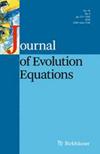修正超临界耗散准地转方程唯一全局解的存在及其在无穷远处的衰减
IF 1.2
3区 数学
Q1 MATHEMATICS
引用次数: 0
摘要
我们在这项研究中的兴趣在于证明当时间趋于无穷大时,修正的准异养方程(MQG)的超临界情况下的唯一全局解的衰减 $$\begin{aligned}\(-\Delta)^{α }\,\theta\,+\, u_{\theta }\0, \quad \hbox {with } u_{\theta }\;=\;(\partial _2(-\Delta )^{\frac{gamma -2}{2}}\theta , -\partial _1(-\Delta )^{\frac{gamma -2}{2}\theta )、\end{aligned}$$in the non-homogenous Sobolev space \(H^{1+\gamma -2\alpha }(\mathbb {R}^2)\), where\(\alpha \in (0,\frac{1}{2})\) and\(\gamma \in (1,2\alpha +1)\).为此,我们需要考虑这个方程的初始数据很小。更准确地说,我们假设(theta _0\Vert _{H^{1+\gamma -2\alpha }})足够小,以便得到一个唯一的(theta in C([0,infty );H^{1+\gamma -2\alpha }(\mathbb {R}^2))\) 解(MQG)并满足以下极限:$$\begin{aligned}.\Lim _{t\rightarrow \infty }\Vert \theta (t)\Vert _{H^{1+\gamma -2\alpha }}=0。本文章由计算机程序翻译,如有差异,请以英文原文为准。
Existence of a unique global solution, and its decay at infinity, for the modified supercritical dissipative quasi-geostrophic equation
Our interest in this research is to prove the decay, as time tends to infinity, of a unique global solution for the supercritical case of the modified quasi-gesotrophic equation (MQG)
$$\begin{aligned} \theta _t \;\!+\, (-\Delta )^{\alpha }\,\theta \,+\, u_{\theta } \cdot \nabla \theta \;=\; 0, \quad \hbox {with } u_{\theta }\;=\;(\partial _2(-\Delta )^{\frac{\gamma -2}{2}}\theta , -\partial _1(-\Delta )^{\frac{\gamma -2}{2}}\theta ), \end{aligned}$$in the non-homogenous Sobolev space \(H^{1+\gamma -2\alpha }(\mathbb {R}^2)\), where \(\alpha \in (0,\frac{1}{2})\) and \(\gamma \in (1,2\alpha +1)\). To this end, we need consider that the initial data for this equation are small. More precisely, we assume that \(\Vert \theta _0\Vert _{H^{1+\gamma -2\alpha }}\) is small enough in order to obtain a unique \(\theta \in C([0,\infty );H^{1+\gamma -2\alpha }(\mathbb {R}^2))\) that solves (MQG) and satisfies the following limit:
$$\begin{aligned} \lim _{t\rightarrow \infty } \Vert \theta (t)\Vert _{H^{1+\gamma -2\alpha }}=0. \end{aligned}$$求助全文
通过发布文献求助,成功后即可免费获取论文全文。
去求助
来源期刊
CiteScore
2.30
自引率
7.10%
发文量
90
审稿时长
>12 weeks
期刊介绍:
The Journal of Evolution Equations (JEE) publishes high-quality, peer-reviewed papers on equations dealing with time dependent systems and ranging from abstract theory to concrete applications.
Research articles should contain new and important results. Survey articles on recent developments are also considered as important contributions to the field.
Particular topics covered by the journal are:
Linear and Nonlinear Semigroups
Parabolic and Hyperbolic Partial Differential Equations
Reaction Diffusion Equations
Deterministic and Stochastic Control Systems
Transport and Population Equations
Volterra Equations
Delay Equations
Stochastic Processes and Dirichlet Forms
Maximal Regularity and Functional Calculi
Asymptotics and Qualitative Theory of Linear and Nonlinear Evolution Equations
Evolution Equations in Mathematical Physics
Elliptic Operators

 求助内容:
求助内容: 应助结果提醒方式:
应助结果提醒方式:


